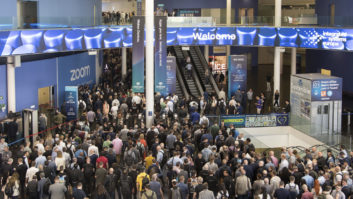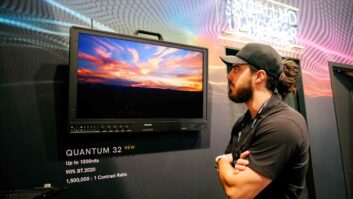
The huge Integrated Systems Europe show each February in Amsterdam has grown rapidly over the last few years, and is now beginning to rival IBC in terms of visitor numbers, exhibitors and floor area.
It is certainly the place to see the latest in display technologies, home cinema, video conferencing, and all sorts of audio-visual equipment for a wide variety of commercial, educational and consumer applications.
Amongst the huge screens on show, many were 4K (or even higher resolution) and/or glasses-free 3D, and rapid adoption of these beyond HD technologies in the consumer and commercial sectors should be good news for anyone producing content at higher resolutions.
One of the biggest flat panel displays was LG’s vast 105-inch Ultra HD 21:9 commercial model, which can be oriented horizontally or vertically in portrait mode – if you want the longest possible coverage. It decodes H.264 or HEVC signals at 30p or 60p. Along side it was the curved 105-inch Ultra HD 21:9 screen previously seen at CES, and LG also introduced more conventional 16:9 98- and 84-inch Ultra HD displays.
Panasonic too showed new 96- and 84-inch 4K LED displays (although they won’t be available until the Autumn, about the same time as its new 4K Varicam), as well as a new 4K large venue projector that boasts new pixel quadrupling technology. This is still in development and is claimed to project “fine life-like details beyond 4K resolution, with exceptional clarity.” Its optical axis is shifted both horizontally and vertically in sync with high frame rate to create four different pixels from a single pixel, to quadruple the pixel density of the projector. The projector also boasts advanced imaging technology.
Panasonic Systems LSI division showed off a single-chip multi-standard decoder (the ProXstream1) that can handle all common formats up to H.264 4K (3840×2160) 30fps, and can up- and down-convert between Full HD and 4K content. It is aimed at 4K digital signage and media player applications.
World’s largest transparent display
At 84-inches, the new 4K Transparent Display panel from Crystal Display Systems is claimed to be the world’s largest.
The screen should “open up many more applications for retail, etc, where certain products, such as full mannequins for designer clothes, could not be used before,” said CDS’ MD, Chris Bartram. Its 3840×2160 resolution “means high-end graphics can be shown which were previously not available in transparent displays” – the largest previously was its 70-inch/1920×1080 screen.
The new display is based on a Sharp 4K panel and has USB, VGA and two HDMI inputs, but “as there is no backlight the actual power consumption is extremely low.” A standard multi-touch IR touchscreen is available with no development or tooling charge.
Transparent displays are being used for retail, exhibition and fashion, and Bartram believes the new 4K panel will “offer an excellent alternative to 3D and Holographic displays with greater flexibility in design and be more cost effective.”
120fps 4K projection
The Christie Mirage 4K is the first 4K projector to deliver 12fps. It is based on Christie’s TruLife electronics, for better image fidelity, vibrant colours and up to 25,000 lumens for the brightest 3D experience. TruLife supports a video-processing pipeline of up to 1.2 Gigapixels per second, which is 10 times faster than full HD bandwidth. This provides flexibility in supporting various 3D interconnectivity formats, including: single sequential 4K 120Hz input, dual interleaved 4K 60Hz signals and 4K 60Hz sequential frame-doubled, with all three formats resulting in 120Hz 4K output.
Also new are Christie’s ‘True 4K’ native resolution projectors, which are based on Texas Instruments’ advanced Series 2 DLP Cinema technology, and are claimed to offer “the richest and most stunning cinematic experiences.” They will also be useful for post production facilities for finishing.
It has also extended its range of LCD flat panels with a 60Hz, 84-inch LCD panel featuring Quad HD resolution (3840×2160).
XUN shines off the wall
NEC Display Solutions Europe added four large format displays to its MultiSync XUN Series, now with thinner bezels and a variety of display improvements, which will give an improved videowall experience. Although they are HD panels, all the digital video inputs can be looped out via the DisplayPort out connector, supporting 4K/UHD resolutions on a 2×2 wall.
An Auto Tile Matrix feature automatically sets up all relevant Tile Matrix settings for an installation when multiple displays are daisy chained via DisplayPort and LAN. Daisy chaining is also improved thanks to an integrated two-port LAN hub. This reduces cabling within videowall installations as the LAN daisy chain function combines LAN, RS232, IR and ambient light sensor into a single network cable.
Display performance is enhanced thanks to the new Frame Comp chip, which cuts out any delay when displaying fast-moving content, helping to stop the slight frame mismatch of individual displays within a wall. The updated range also incorporates an NFC sensor and matching app for Android devices that simplifies configuration.
Glasses-free 3D 12K
One demonstration of NEC’s linked displays was given by Tridelity (pictured here on the NEC stand), which showed a glasses-free 3D video wall offering extremely high resolutions (up to 12K) aimed at digital signage.
The video walls use NEC’s HD 55-inch displays in a variety of formats and combinations (3×1, 2×2, 3×3 or 4×3 and others), with a 3×1 configuration on show at ISE using Ultra Narrow NEC MultiSync X551UN displays that have a frame of only 5mm. The system can also convert 2D content into 3D.
“Our reference customers in the field of advertising already indicate the strong interest and the increasing trend towards the use of glasses-free 3D displays,” said Tridelity CEO, Michael Russo.
On test
The new DVDO AVLab TPG is “the first 4K test pattern generator for doing display calibrations that is a reasonable cost,” said Matt Murray, marketing manager for AVPro Alliance. It costs $1299.
“It’s small, fits in your pocket, whereas the next 4K test pattern generator comes in a case and starts in the $5000 range,” he added.
By David Fox
www.avproalliance.com
www.christiedigital.co.uk
www.crystal-display.com
www.lg.com
www.nec-display-solutions.com
http://business.panasonic.co.uk
www.tridelity.com





